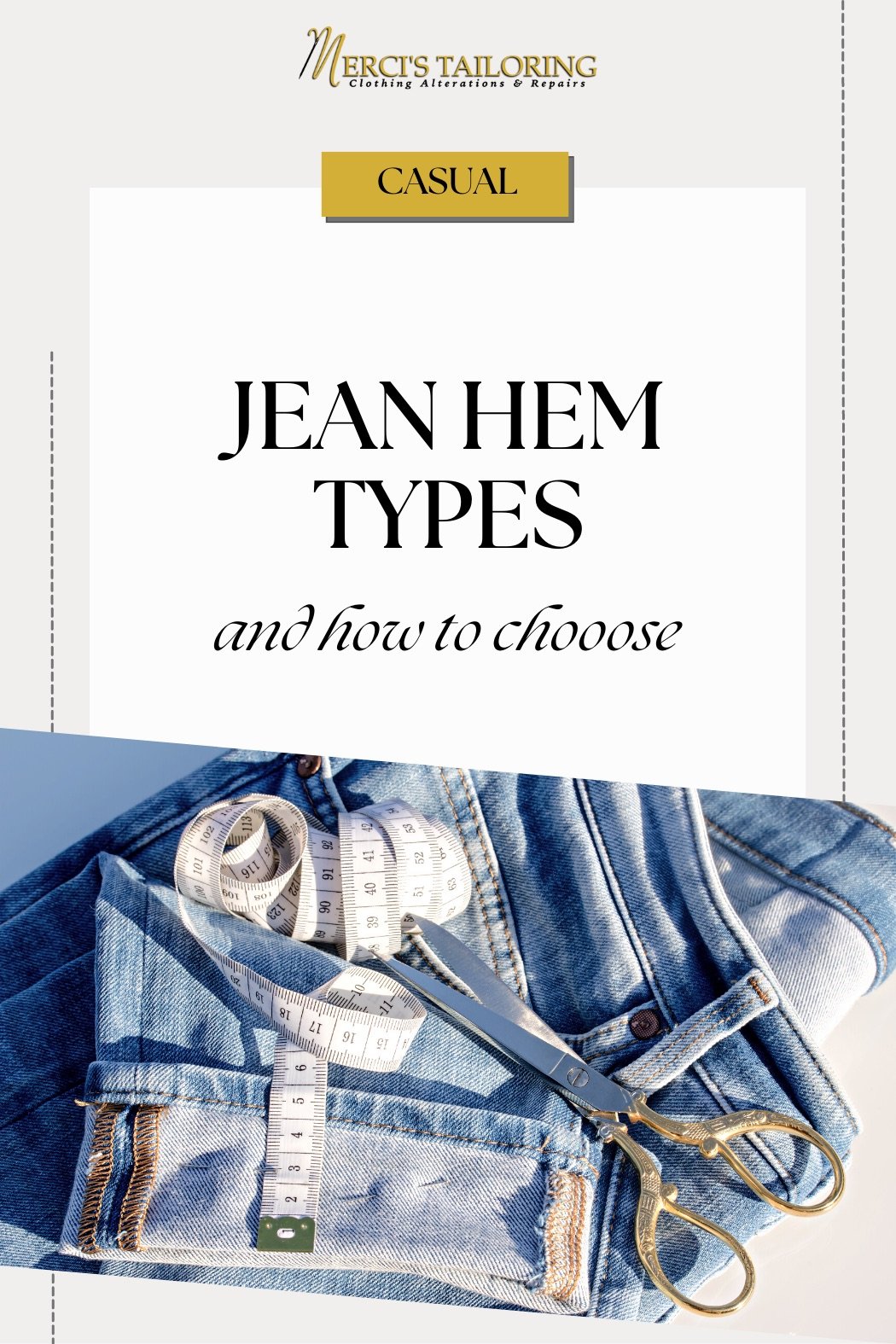Jean hem types & how to choose
A new customer walks into our Cedar Rapids tailoring shop with a pair of jeans fresh off the rack, tags still attached. They have a classic problem: their new jeans are too long.
Since the beginning of mass manufacturing, customers have been finding new pants too long and ultimately need to either embrace the cuff-life, or visit the tailor.
The Merci’s Tailoring family is all too familiar with this problem. A majority of us are on the shorter end of the bell curve, and therefore can not ever find pants in our correct length; even petite sizes!
So with a sense of kinship, we happily measure and pin up the altered length for our customer and start to prepare their order. Once out of the dressing room, we ask, “What kind of hem would you like on your jeans today?”
Huh? What kind of hem? I don’t know… a shorter one?
Next to our formal wear alterations, pant and jean hemming is probably our 2nd most common alteration. That’s right, we don’t just do dresses and suits!
And while hemming slacks, khakis, and dress pants is pretty straightforward, denim jean hems come with some options due to their style.
So join us in today’s blog post where we go through those jean-hemming options, and how you can choose the hem for your next new pair, or currently cuffed pair, of jeans.
What makes hemming jeans different
For most other types of pants, like the slacks, khakis, and dress pants mentioned above, their fabric’s color and texture is the same all the way from the waistband to the hem.
This makes hemming simple because if you cut off the original hem the pant came with, fold the edge, and sew the new hem with a standard matching thread, the finish is exactly the same. The pants look as if they came that length from the factory, and there really isn’t any way to distinguish them from the original.
As a contrast, if you’ve ever looked a bit closer at the bottom of your pair of jeans, you may notice a couple of distinctive features that make jean hems special: the distressed denim coloring, and the thick denim top stitching.
The distressed coloring is obviously an ingrained part of the fabric on the hem of the jean, and therefore cannot be replicated if you remove it. But what about the thread?
The thread used for top stitching typically comes in an easily replicable assortment of colors, as shown here in this collection sold by our favorite supplier, Wawak.
Much like zippers, thread colors can be very unique to manufacturers. Clothing manufacturers order hundreds of spools of thread at a time, which means it is worth the suppliers’ while to create a thread color, or even size, that is more unique for a particular garment design. Individual tailors and home sewers, however, have less choice because they are only buying one, or maybe a handful, of spools at time. So the suppliers for this area of the market limit selection to the most common colors and sizes. All this to say that your seamstress cannot always perfectly match the top thread on your favorite denim, but they can often get pretty close.
So how do you hem a pair of pants with a distinctive finish on the hem?
This leads us to the 3 common denim hem types:
Each deal with the distressed denim coloring and thick contrasting denim top stitch thread differently to achieve the particular finish you’re looking for.
At the end of our article, we also have an FAQ section all about specialty jean hems.
Standard jean hem
Starting off with the simplest hem option for jeans. The standard hem is the kind of hem we’d give to any other kind of pant. The excess is cut off at the bottom, the raw edge is folded over and sewn down.
Of course this means that the distressed denim look is ultimately lost in the final hem. The alteration specialist will still use the best matching thread available to achieve a resemblance to the original finish.
Why would you choose this hem finish? This is chosen when the client has no preference about keeping that distressed denim coloration on the original hem, and perhaps also would like to save a few dollars.
When opting for a standard hem, be sure to look at the top stitch thread, even if you don’t care to keep the distressed fabric edge. If your jeans come with a particular unique top stitch thread, it’s extremely thick, or an abnormal color, the seamstress might not be able to match the thread with what is available on hand. In this case, you may want to consider our next jean hem option.
Should you choose this hem style?
Do you care to keep the “wear” coloration on the hem? - No
Can the tailor match the top stitch thread? - Yes
If your answers matched the ones above, then this jean hem style might be the one for you!
Original jean hem
With the standard hem, if you cut the length directly off the bottom and make new hem, you lose that finished jean look. This hem technique keeps that original hem in its entirety by removing the original hem and reattaching it at a new position, achieving a shorter length.
Essentially you’re moving the original hem up the pant leg. This creates excess fabric inside the leg that’s being “pinched out”, so this is reduced with serging and tacked in place with a few stitches on the side seams and each of the centers. Finally a very small top stitch in the closest matching thread is sewn just above the hem to help it lay flat.
If you want to maintain the exact original hem look on your denim, then not removing it at all can be the best choice! Since this technique has a few more steps, it will cost you a few extra dollars compared to the standard hem.
Since the entire hem is being moved up, including the top stitching, the tailor doesn’t need to worry about matching the thread.
Should you choose this hem style?
Do you care to keep the “wear” coloration on the hem? - Yes
Are you bothered by the inside flap? - No
Can the tailor match the top stitch thread? - N/A
If your answers matched the ones above, then this jean hem style might be the one for you!
Euro jean hem
In our Cedar Rapids alterations shop, we don’t perform this hem nearly as much as the original hem method above. It takes a couple extra steps, so that means it’s the most expensive hem option. Most customers are perfectly happy with the original hem above.
The Euro jean hem is like a mix of the two previous denim hemming techniques. The fabric of the original hem is moved up the pant leg, just like with the original hem technique. The thread, however, is removed and needs to replaced with its closest match. This is done because the extra fabric created from cutting and reattaching the original hem is actually going to be sewn inside the opened original hem.
This creates the cleanest inside finish, so if you really don’t like having a flap inside your pant leg, ask for the Euro hem when you visit the tailor. And if you can’t remember what it’s called, just ask for the hem that folds the extra back inside. They’ll know what you’re talking about.
Since this technique requires opening the original hem in order to fold the extra fabric back inside, the original top stitch thread is being removed so the seamstress needs to replace it with a close match. If again, your jeans have a very unique top stitch thread, this may not be the best option for your denim. If you would like to choose this hem technique, be sure to ask your tailor if they have a matching top stitch thread.
Should you choose this hem style?
Do you care to keep the “wear” coloration on the hem? - Yes
Are you bothered by the inside flap? - Yes
Can the tailor match the top stitch thread? - Yes
If your answers matched the ones above, then this jean hem style might be the one for you!
Ready to turn your rolled cuffs into properly shortened jeans?
Schedule your fitting conveniently on the NE side of Cedar Rapids today!
Jean hemming FAQ
Can you shorten frayed edge or raw hem jeans?
Yes you can shorten raw hem jeans!
For jeans with a frayed or raw edge, we will use the “original” method, and move the whole hem up the pant leg for the new desired length. There will be a tiny, nearly invisible seam at the very top of the fraying to hold the hem at its new place.
Can you shorten jeans with a button on the hem?
If your jean hem has a button, there are a few options to shorten them.
If the button has a true matching button hole on an opposite flap, and you’d like to keep that button hole, we will probably look to raise the entire hem. This will create a seam, but with matching thread, it won’t be overtly noticeable. If you’d like to avoid any additional seam, you may have to lose that button hole, but we can still attach the button on the new hem as a decoration. You won’t be able to tell the difference by just looking at it!
Can you do an original hem on bell bottom jeans?
Yes! While this needs a little more skill and technique, you can often keep an original hem on wide-legged or bell bottom jeans.
Because of the dramatic flare in wide-legged pants, the original hem will be a bit wider than where the pants will be shortened.
The tailor will use a technique to help the hem match the width of the new hem placement. Alternatively, if the bell bottom pants have a particularly tall hem decoration, then it may be a better option to shorten them at the knee. This involves removing the appropriate amount of fabric from the knee instead of the bottom of the pant. This will create a seam at the knee, which can be discrete by using matching thread. Or you can turn it into a design element with contrasting thread.
Hemming at the knee is also a good option so that you don’t lose any of the flare in your wide legged jeans. If you’re worried about losing that width, be sure to bring that up with your seamstress so this can be considered when choosing a hemming technique.
Can you shorten jeans with a zipper on the leg?
If your jeans come with a zipper down the bottom of the leg to the hem, they can still be shortened. Depending on the type of zipper, how the zipper is sewn into the pant, and your preference, the tailor can either move the entire zipper up the leg so it keeps its same length while the pant itself is shortened, or the zipper can be cut and a standard hem is done.
Can you shorten split leg jeans?
Split leg jeans are a popular denim fashion right now! They feature an open seam on one side of the leg to create a flared effect.
Your trendy split leg jeans can definitely be hemmed, they can even keep the original hem. However, whether you can shorten them without losing any or all of that split will depend on the design of your specific pair of jeans.
If you’re on the shorter side like us, another option is to purchase a standard pair of jeans (bootleg cut would work well here) and ask your tailor to open the side seams to create a split leg jean custom for you! Then you get to choose exactly how short you’d like the jeans to be, and how high you’d like the split. Perfect!













